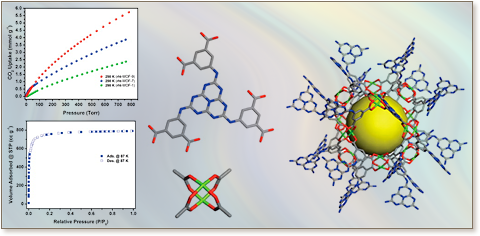
We have successfully used the rht-MOF platform to prepare a nitrogen-rich functionalized rht-MOF-9, which exhibits a highly specific surface area in combination with high charge density. By incorporating a ligand having an s-heptazine central core linked to three isophthalic acid moieties through secondary amines, rht-MOF-9 exhibits high CO2 uptake at both relatively low (0.1 bar) and atmospheric pressures. In addition H2 storage capacity at 1 bar and 77 K was found to be exceptionally high in comparison to other reported MOFs and is the highest reported low pressure uptake for rht-MOFs. Further adsorption studies are in progress to evaluate the performance of rht-MOF-9 for CO2 separation in the presence of N2, CH4, and H2 containing gas mixtures as well as hydrogen and methane storage at relatively high pressures.
Here we synthesized the highly porous rht-MOF-9 as the first example of an rht-MOF having a polycyclic central core. This material was synthesized from a predesigned polyheterocyclic nitrogen-rich hexacarboxylate (tri-isophthalate) ligand, which serves as the 3-connected, trigonal molecular building block (MBB). When reacted under the proper conditions, this ligand, having three coplanar isophthalic acid moieties, codes for the in situ formation of the targeted 24-connected copper-based supermolecular building block (SBB) having rhombicuboctahedral geometry. This combination of a 24-connected building block linked through 3-connected nodes results in a novel material with the singular rht topology. The rht-MOF-9 compound exhibits promising H2 and CO2 adsorption properties in comparison to previously reported rht-MOFs.


